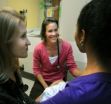(Press-News.org) Sweden's only remaining cold-water coral reef, the Säcken reef in the Koster Fjord, is under threat of extinction. Because of that, researchers from the University of Gothenburg have started a restoration project where healthy corals from nearby reefs in Norway are being removed and placed on the Säcken reef.
Coral reefs are known for their rich biological diversity. In Sweden, only one reef-building coral species exists, a cold-water coral called Lophelia pertusa. Lophelia pertusa requires an environment with a constant high level of salinity and low water temperatures all year round. In Sweden, these conditions only exist in the northern part of Bohuslän, where deep water from the Atlantic is led in via the Norwegian Trench.
"We've known since the mid-1920s that cold-water coral reefs exist here in Sweden," says marine biologist and researcher Mikael Dahl. "At that time, corals could be found in three locations in the Koster Fjord. Today, only the Säcken reef remains, and it's in poor condition."
Some of the causes to this are the impact of trawling and increased sedimentation from eutrophication. Continuous observations with remotely operated vehicles (ROV:s) shows that the health of the reef slowly continues to decline.
"The red list assessment is currently in the 'under immediate threat' category. The Säcken reef has been protected against trawling for more than a decade, but trawling damage have been observed on the reef several times after the legislation was set in place", says Mikael Dahl.
Three years ago, the protection of the reef was further strengthened when Sweden's first national marine park, the Kosterhavet National Park, was created. However, the Säcken reef remains in poor condition.
Coral reefs are entirely dependent on larvae from other reefs in order to recover naturally after they have been damaged, and the researchers have for a long period of time set their hopes to larvae from the nearby coral reefs in Norwegian waters. However, a study recently published in the research journal Coral Reefs, shows that the Säcken reef is isolated from the other reefs in the northeast Skagerrak.
By using genetic markers, researchers have estimated the degree of gene flow between the reefs in Skagerrak. The results show that the genetic distance between the Säcken reef and four other reefs in the northeast Skagerrak is one of the largest on both sides of the Atlantic. The genetic diversity on the Säcken reef is also much lower than observed in any other reef of this type.
"This means that it is highly unlikely that the Säcken reef will recover naturally," says Mikael Dahl, who led the study. "Instead, interventions are needed in order to ensure the survival of the reef."
The importance of starting restoration
On the basis of these results, researchers from the University of Gothenburg have started a restoration project where healthy corals from nearby reefs in Norway are being removed and placed on the Säcken reef after being genetically characterised. The researchers hope that these corals will survive the process of being transferred, and that they will be able to help with the re-establishment of the reef, through both asexual and sexual reproduction.
The Säcken reef is spread across an area of 5,000 m², but today there is only living coral in an area of around 300-500 m². Further results from the study show that individual specimens of Lophelia pertusa corals may be several thousands of years old, and in the Norwegian coral reef some of the individuals have been estimated to be somewhat 6,200 years old. But many are probably older.
"In other words, it's not only the reefs themselves that are extremely old, but it's also actually the same individuals that have been situated there since soon after the withdrawal of the inland ice. These individual corals have been living there in the deep darkness since long before the Pharaohs built the pyramids", says Mikael Dahl.
###Contact: Mikael Dahl
Department of Biological and Environmental Sciences
mikael.dahl@bioenv.gu.se
+46 70 3217371
Sweden's only coral reef at risk of dying
2012-10-22
ELSE PRESS RELEASES FROM THIS DATE:
ESF's EMRC calls for the adoption of open access in biomedical sciences
2012-10-22
The European Science Foundation's (ESF) membership organisation for all medical research councils in Europe, the European Medical Research Concils (EMRC) has today released an ESF-EMRC Science Policy Briefing (SPB) entitled 'Open Access in Biomedical Research' highlighting the need to accelerate the adoption of open access to research articles in the biomedical sciences across Europe.
Over the past few months, various reports and communications have been published on the topic of open
access. These include the Finch Group report on 18 June 2012, the Publishing and the ...
Biomarkers in cerebrospinal fluid can identify patients with Alzheimer's disease
2012-10-22
Analysis of specific biomarkers in a cerebrospinal fluid sample can differentiate patients with Alzheimer's disease from those with other types of dementia. The method, which is being studied by researchers at Sahlgrenska Academy, may eventually permit earlier detection of Alzheimer's disease.
Due to the similarity of the symptoms, differentiating patients with Alzheimer's from those with other types of dementia – or patients with Parkinsondisease from those with other motor disorders – is often difficult.
Making a proper diagnosis is essential if proper treatment ...
Climate change threatens marine environment in the Baltic Sea
2012-10-22
At the end of the 21st century, the temperature in the Baltic Sea will be higher and the salt content lower than at any time since 1850. If no action is taken to alleviate the effects of climate change, there may be major consequences for the marine environment.
"This is the first time that anyone has taken a detailed look at how climate models and individual factors combine to affect a specific region. This makes this project unique," says Jonathan Havenhand from the Department of Biological and Environmental Sciences at the University of Gothenburg, Sweden.
A large ...
Aspirin may slow the decline in mental capacity among elderly patients
2012-10-22
A daily dose of acetylsalicylic acid equivalent to a fourth of an aspirin may slow the decline in intellectual capacity among elderly individuals with high cardiovascular risk.
This is shown in a study by Sahlgrenska Academy, University of Gothenburg, Sweden.
Researchers at Sahlgrenska Academy, University of Gothenburg, over a five year period studied how intellectual capacity changes among 681 elderly women (70 to 92 years) with heightened risk of suffering from a heart attack, vascular spasm or stroke.
Of the 681 women, 129 received a low daily dose of acetylsalicylic ...
The hidden threat posed by inconspicuous stripes
2012-10-22
Patterns fascinate. Particularly stripes. Found in nature in zebras, they are also found in the most unlikely places, such as powdered drugs' mixing vessel walls. In an article about to be published in EPJ E, Nirmal Thyagu and his colleagues from Rutgers University, New Jersey, USA, propose a traffic model to predict the formation of different patterns, ranging from stripes to spots.
Thanks to simulations, Thyagu and colleagues showed the underlying stripe formation mechanism, which they propose stems from traffic-like jams, whereby particles move more slowly when surrounded ...
Saving time, saving lives
2012-10-22
Istanbul, 22 October 2012: Experts in emergency cardiac care from around the world met in Istanbul to discuss ways to improve outcomes in patients with acute cardiac disease. This was the first annual meeting of the newly launched Acute Cardiovascular Care Association (ACCA) of the European Society of Cardiology (ESC) (1). The congress concludes today.
"The key message is that time saves lives," said Professor Tom Quinn, United Kingdom, member of the ACCA Board. "In cardiac emergencies, such as a heart attack, calling an ambulance immediately ensures the patient gets ...
Immune cells of the blood might replace dysfunctional brain cells
2012-10-22
This press release is available in German.
The immune system is comprised of multiple cell types each capable of specialized functions to protect the body from invading pathogens and promote tissue repair after injury. One cell type, known as monocytes, circulates throughout the organism in the blood and enters tissues to actively phagocytose (eat!) foreign cells and assist in tissue healing. While monocytes can freely enter most bodily tissues, the healthy, normal brain is different as it is sequestered from circulating blood by a tight network of cells known as the ...
Mock clinical exams boost pediatric residents' comfort in addressing breastfeeding
2012-10-22
AUGUSTA, Ga. – A simulated clinical experience guiding future pediatricians through interactions with breastfeeding moms appears to put the doctors at ease with the sensitive and important health topic, researchers say.
"We showed that their confidence and comfort increased with the OSCE (Objective Structured Clinical Examination) interventions," said Dr. Kathryn McLeod, a pediatrician and educator at the Medical College of Georgia at Georgia Health Sciences University who developed the three simulated patient exams.
Breastfeeding education typically falls to pediatricians ...
Gastric bypass surgery just as effective in teenagers as in adults
2012-10-22
Teenagers with severe obesity can benefit from gastric bypass surgery just as much as adults. A study by Sahlgrenska Academy, University of Gothenburg, Sweden and Karolinska Institutet, Sweden found that 81 teenagers lost an average of 96.8 pounds following surgery, significantly improving their health and quality of life.
The study, published by the International Journal of Obesity, involved eighty-one 13-18 year-olds who had gastric bypass surgery, which had previously been performed on people younger than 18 in exceptional cases only.
The new study found that gastric ...
Want the shortest path to the good life? Try cynicism
2012-10-22
Are cynics and happiness mutually exclusive? For modern cynics, perhaps. But for the ancient Cynics, not necessarily.
Research by the University of Cincinnati's Susan Prince shows that despite the historical perception of the ancient Cynics as harsh, street-corner prophets relentlessly condemning all passersby and decrying society's lack of virtue, these Greek philosophers, indirectly descended from Socratic teaching, weren't all doom and gloom. They actually might have espoused a shortcut to happiness.
"We don't have good scholarship on the Cynics. They're seen as ...

